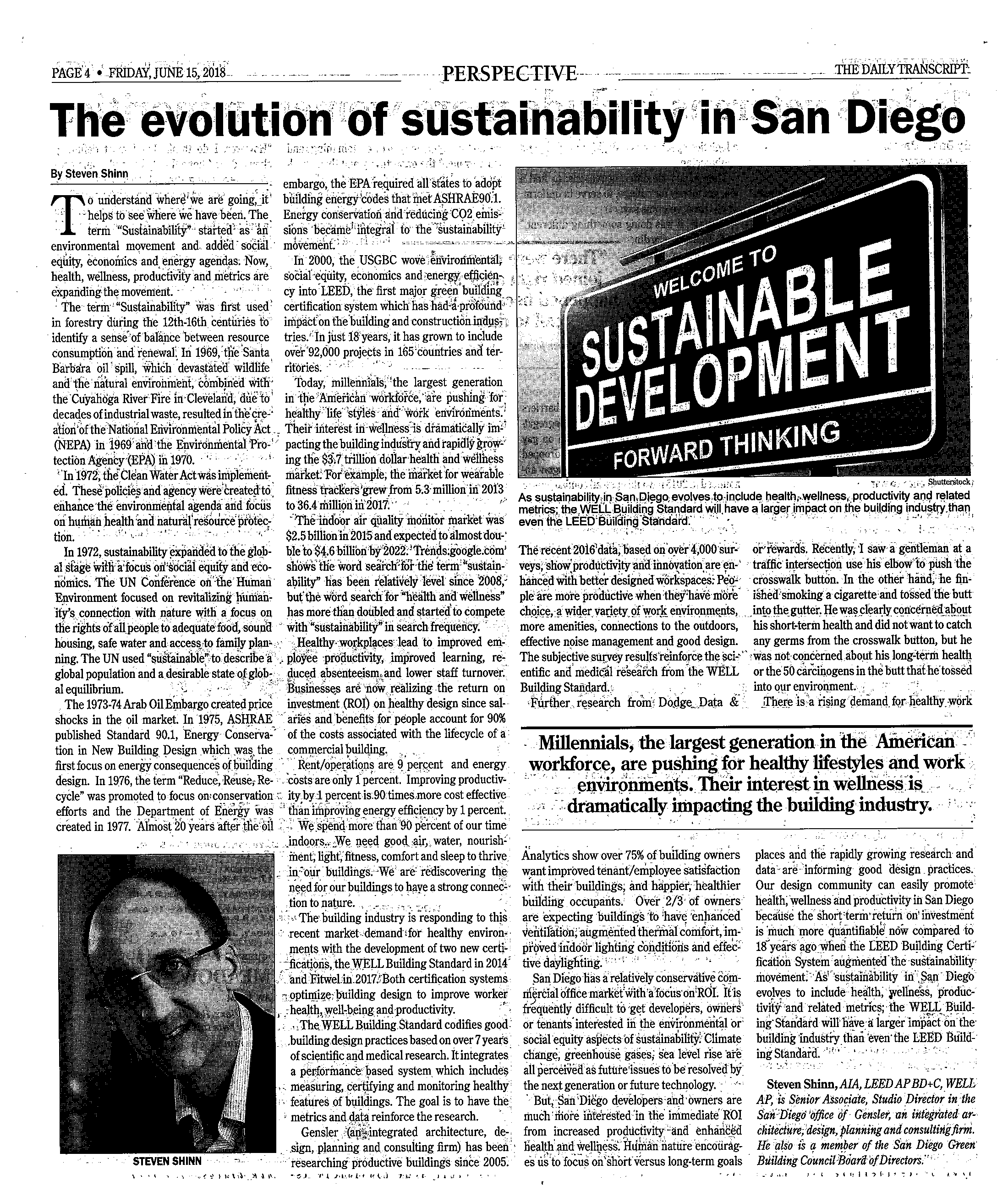2018 AIA San Diego President, Steven Shinn, AIA offered his perspective on the evolution of sustainability in San Diego on June 15, 2018.

To read his op-ed, continue below:
The Evolution of Sustainability in San Diego
Sustainability is evolving in San Diego to include health, wellness, productivity and metrics.
To understand where we are going, it helps to see where we have been. The term “Sustainability” started as an environmental movement and added social equity, economics and energy agendas. Now, health, wellness, productivity and metrics are expanding the movement.
The term “Sustainability” was first used in forestry during the 12th-16th centuries to identify a sense of balance between resource consumption and renewal. In 1969, the Santa Barbara oil spill, which devastated wildlife and the natural environment, combined with the Cuyahoga River Fire in Cleveland, due to decades of industrial waste, resulted in the creation of the National Environmental Policy Act (NEPA) in 1969 and the Environmental Protection Agency (EPA) in 1970. In 1972, the Clean Water Act was implemented. These policies and agency were created to enhance the environmental agenda and focus on human health and natural resource protection.
In 1972, sustainability expanded to the global stage with a focus on social equity and economics. The UN Conference on the Human Environment focused on revitalizing humanity’s connection with nature with a focus on the rights of all people to adequate food, sound housing, safe water and access to family planning. The UN used “sustainable” to describe a global population and a desirable state of global equilibrium.
The 1973-74 Arab Oil Embargo created price shocks in the oil market. In 1975, ASHRAE published Standard 90.1, Energy Conservation in New Building Design which was the first focus on energy consequences of building design. In 1976, the term “Reduce, Reuse, Recycle” was promoted to focus on conservation efforts and the Department of Energy was created in 1977. Almost 20 years after the oil embargo, the EPA required all states to adopt building energy codes that met ASHRAE90.1. Energy conservation and reducing CO2 emissions became integral to the sustainability movement. In 2000, the USGBC wove environmental, social equity, economics and energy efficiency into LEED, the first major green building certification system which has had a profound impact on the building and construction industries. In just 18 years, it has grown to include over 92,000 projects in 165 countries and territories.
Today, millennials, the largest generation in the American workforce, are pushing for healthy life styles and work environments. Their interest in wellness is dramatically impacting the building industry and rapidly growing the $3.7 trillion dollar health and wellness market. For example, the market for wearable fitness trackers grew from 5.3 million in 2013 to 36.4 million in 2017. The indoor air quality monitor market was $2.5 billion in 2015 and expected to almost double to $4.6 billion by 2022. Trends.google.com shows the word search for the term “sustainability” has been relatively level since 2008, but the word search for “health and wellness” has more than doubled and started to compete with “sustainability” in search frequency.
Healthy workplaces lead to improved employee productivity, improved learning, reduced absenteeism and lower staff turnover. Businesses are now realizing the return on investment (ROI) on healthy design since salaries and benefits for people account for 90% of the costs associated with the lifecycle of a commercial building. Rent / operations are 9% and energy costs are only 1%. Improving productivity by 1% is ninety times more cost effective than improving energy efficiency by 1%.
We spend more than 90% of our time indoors. We need good air, water, nourishment, light, fitness, comfort and sleep to thrive in our buildings. We are rediscovering the need for our buildings to have a strong connection to nature. The building industry is responding to this recent market demand for healthy environments with the development of two new certifications, the WELL Building Standard in 2014 and Fitwel in 2017. Both certification systems optimize building design to improve worker health, well-being and productivity. The WELL Building Standard codifies good building design practices based on over 7 years of scientific and medical research. It integrates a performance based system which includes measuring, certifying and monitoring healthy features of buildings. The goal is to have the metrics and data reinforce the research.
Gensler (an integrated architecture, design, planning and consulting firm) has been researching productive buildings since 2005. The recent 2016 data, based on over 4,000 surveys, show productivity and innovation are enhanced with better designed workspaces. People are more productive when they have more choice, a wider variety of work environments, more amenities, connections to the outdoors, effective noise management and good design. The subjective survey results reinforce the scientific and medical research from the WELL Building Standard.
Further research from Dodge Data & Analytics show over 75% of building owners want improved tenant/employee satisfaction with their buildings, and happier, healthier building occupants. Over 2/3 of owners are expecting buildings to have enhanced ventilation, augmented thermal comfort, improved indoor lighting conditions and effective daylighting.
San Diego has a relatively conservative commercial office market with a focus on ROI. It is frequently difficult to get developers, owners or tenants interested in the environmental or social equity aspects of sustainability. Climate change, greenhouse gases, sea level rise are all perceived as future issues to be resolved by the next generation or future technology. But, San Diego developers and owners are much more interested in the immediate ROI from increased productivity and enhanced health and wellness. Human nature encourages us to focus on short versus long-term goals or rewards. Recently, I saw a gentleman at a traffic intersection use his elbow to push the crosswalk button. In the other hand, he finished smoking a cigarette and tossed the butt into the gutter. He was clearly concerned about his short-term health and did not want to catch any germs from the crosswalk button, but he was not concerned about his long-term health or the 50 carcinogens in the butt that he tossed into our environment.
There is a rising demand for healthy work places and the rapidly growing research and data are informing good design practices. Our design community can easily promote health, wellness and productivity in San Diego because the short term return on investment is much more quantifiable now compared to 18 years ago when the LEED Building Certification System augmented the sustainability movement. As sustainability in San Diego evolves to include health, wellness, productivity and related metrics; the WELL Building Standard will have a larger impact on the building industry than even the LEED Building Standard.
Steven Shinn, AIA, LEED AP BD+C, WELL AP Senior Associate, Studio Director Gensler









